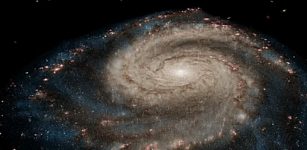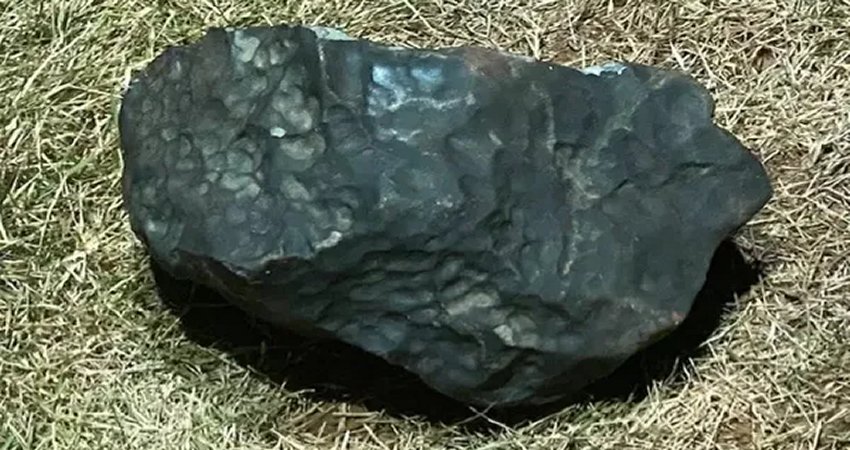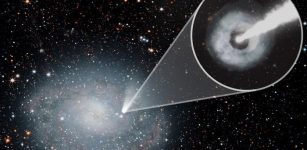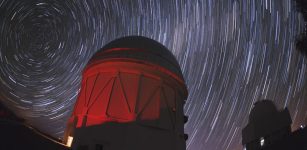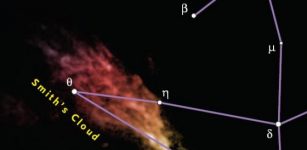Thanks To Webb Webb Scientists Examine Turbulent Nature Of Nebula NGC 1514
Eddie Gonzales Jr. – MessageToEagle.com – Thanks to mid-infrared data from the James Webb Space Telescope, gas and dust ejected by a dying star at the heart of NGC 1514 came into complete focus.
Its rings, which are only detected in infrared light, now look like fuzzy clumps arranged in tangled patterns, and a network of clearer holes close to the central stars shows where faster material punched through.
The James Webb Space Telescope has captured the most detailed image of planetary nebula NGC 1514 using mid-infrared observations. It reveals the rings as “fuzzy” dust clumps and highlights holes in the bright pink center.
[Image description: What looks like a single large, bright star (but is two) shines with bright purple diffraction spikes at the center of a large, diffuse cylinder of gas and dust that is tipped to the right. At the center is a bright pink clumpy cloud that takes up about 25% of the view. There are two large rings seen at a roughly 60-degree angle that appear joined at top left and bottom right. The edges are denser, and form shallow V-shapes that go inward. The rings appear orange at top left and bottom right, and are blue at bottom and center right. There is diffuse orange material around the body. The black background of space is speckled with tiny stars and galaxies mostly in blues and yellows. Areas Webb did not observe are along the top edges, a thin vertical near the nebula at top left, and at the bottom left and right corners.]Credit: NASA, ESA, CSA, STScI, Michael Ressler (NASA-JPL), Dave Jones (IAC)
The rings around NGC 1514 were discovered in 2010, but now Webb is allowing scientists to comprehensively examine the turbulent nature of this nebula.
This scene has been forming for at least 4,000 years — and will continue to change over many more millennia. At the center are two stars that appear as one in Webb’s observation, and are set off with brilliant diffraction spikes. The stars follow a tight, elongated nine-year orbit and are draped in an arc of dust represented in orange.
One of these stars, which used to be several times more massive than our Sun, took the lead role in producing this scene. Once the star’s outer layers were exhausted, only its hot, compact core remained. As a white dwarf star, its winds both sped up and weakened, which might have swept up material into thin shells.
Its hourglass shape
Webb’s observations indicate the nebula is angled at 60 degrees, resembling a pouring can. However, NGC 1514 likely has an hourglass shape with truncated ends. Notice hints of its pinched waist where orange dust forms shallow V-shapes near the top left and bottom right. At its peak of material loss, the star’s companion may have come very close, creating these unusual shapes and possibly forming rings instead of a sphere.
Though the outline of NGC 1514 is clearest, the hourglass also has “sides” that are part of its three-dimensional shape. Look for the dim, semi-transparent orange clouds between its rings that give the nebula body.
A network of dappled structures
The nebula’s two rings are unevenly illuminated in Webb’s observations, appearing more diffuse at bottom left and top right. They also look fuzzy, or textured. Scientists believe the rings are primarily made up of very small dust grains, which, when hit by ultraviolet light from the white dwarf star, heat up enough to be detected by Webb.
In addition to dust, the telescope also revealed oxygen in its clumpy pink center, particularly at the edges of the bubbles or holes.
NGC 1514 is notable for lacking carbon and polycyclic aromatic hydrocarbons, common in planetary nebulae. These weren’t detected because the orbit of its two central stars mixed the ejected material, preventing complex molecules from forming. The simpler composition allows light from both stars to reach farther, revealing faint, cloud-like rings.
What about the bright blue star to the lower left with slightly smaller diffraction spikes than the central stars? It’s not part of this scene. In fact, this star lies closer to us.
This planetary nebula has been studied since the late 1700s. In 1790, William Herschel noted NGC 1514 as the first deep sky object appearing genuinely cloudy, unlike other clusters he saw. With Webb, our view is now clearer.
NGC 1514 lies in the Taurus constellation approximately 1,500 light-years from Earth.
Source – European Space Agency
Written by Eddie Gonzales Jr. – MessageToEagle.com Staff Writer


